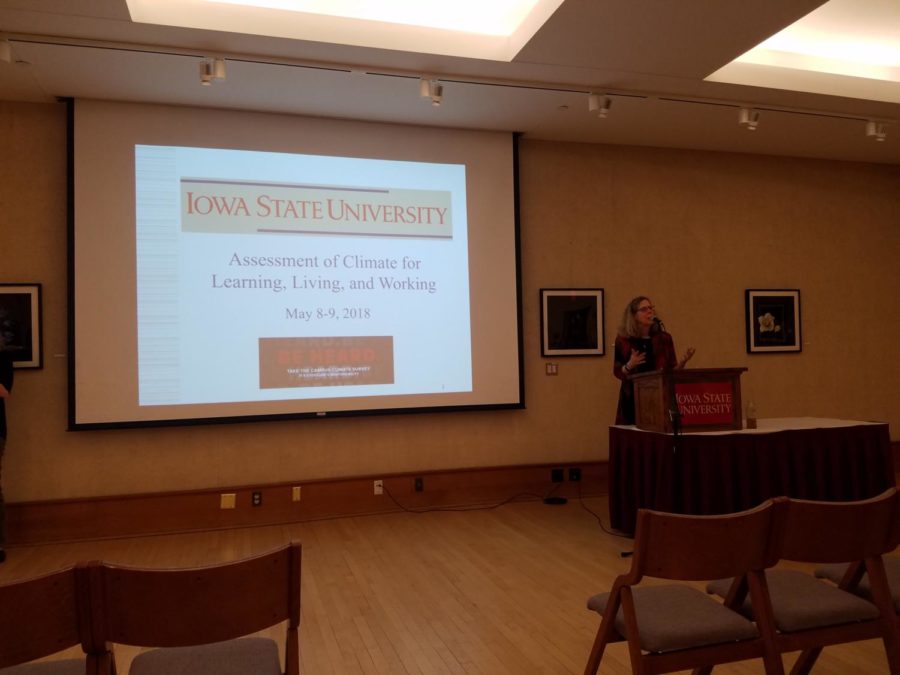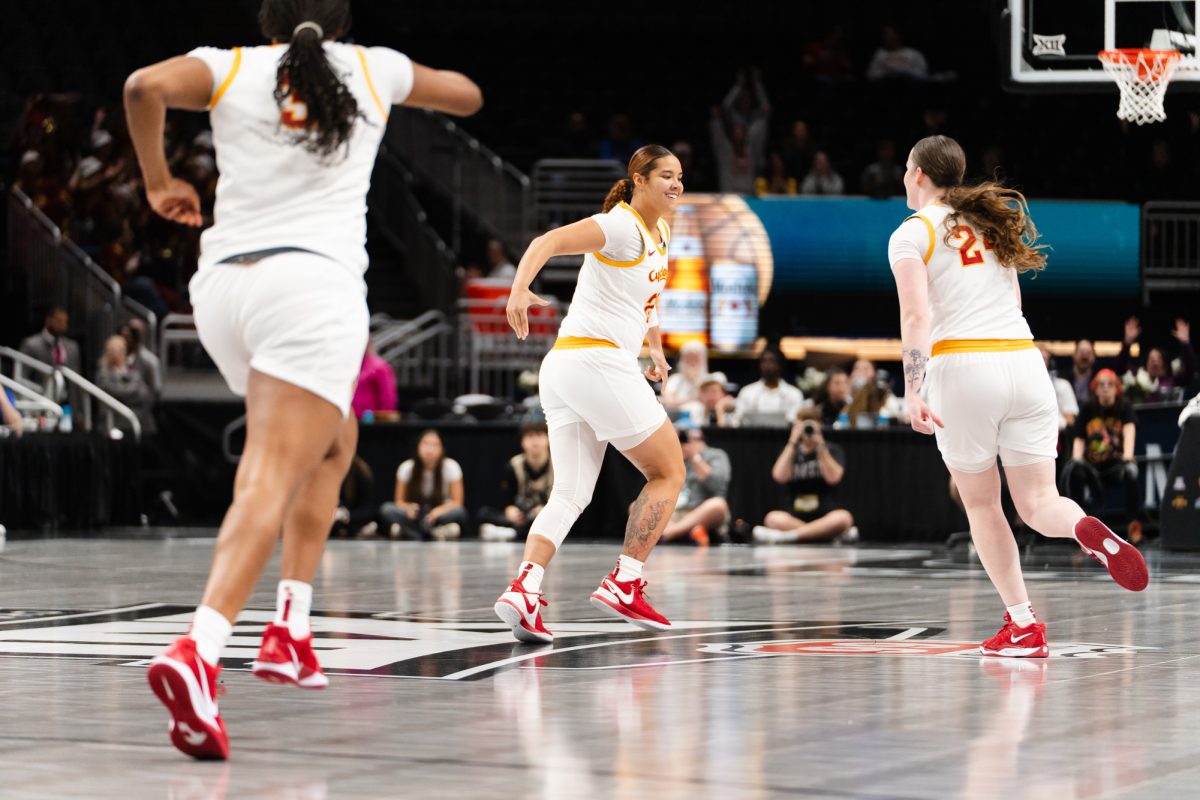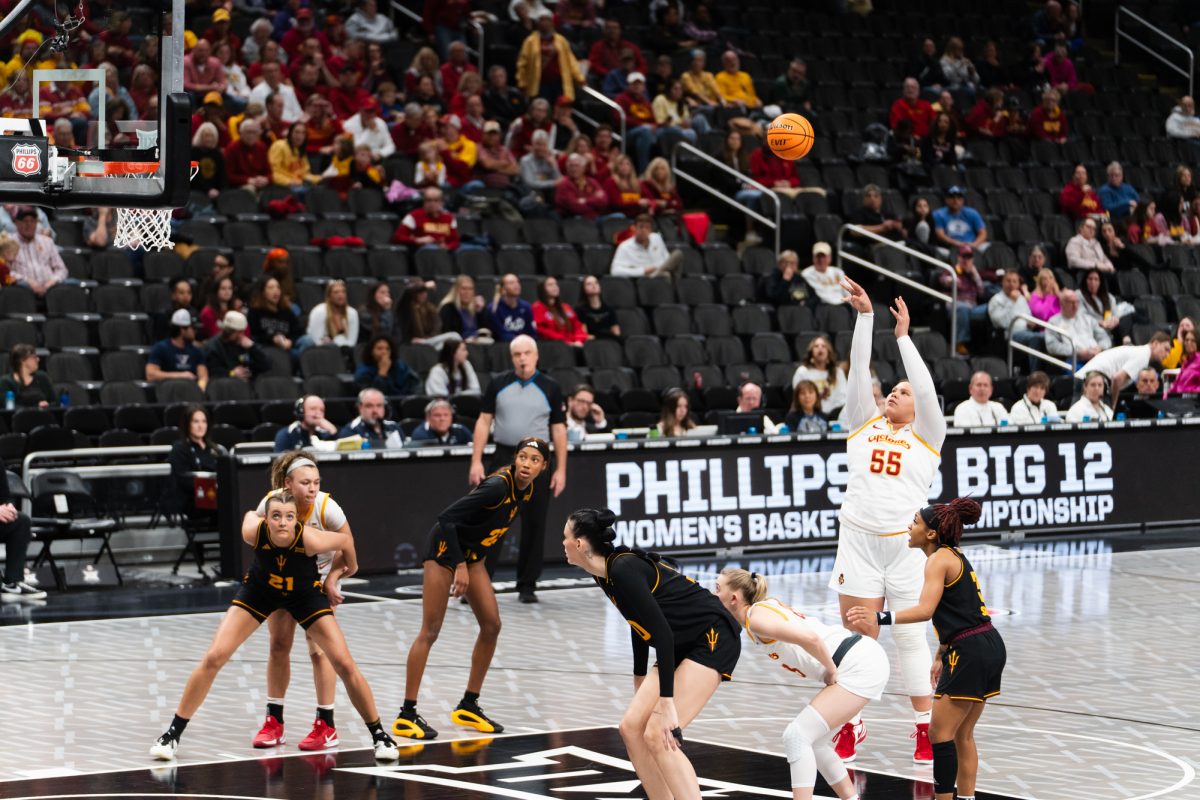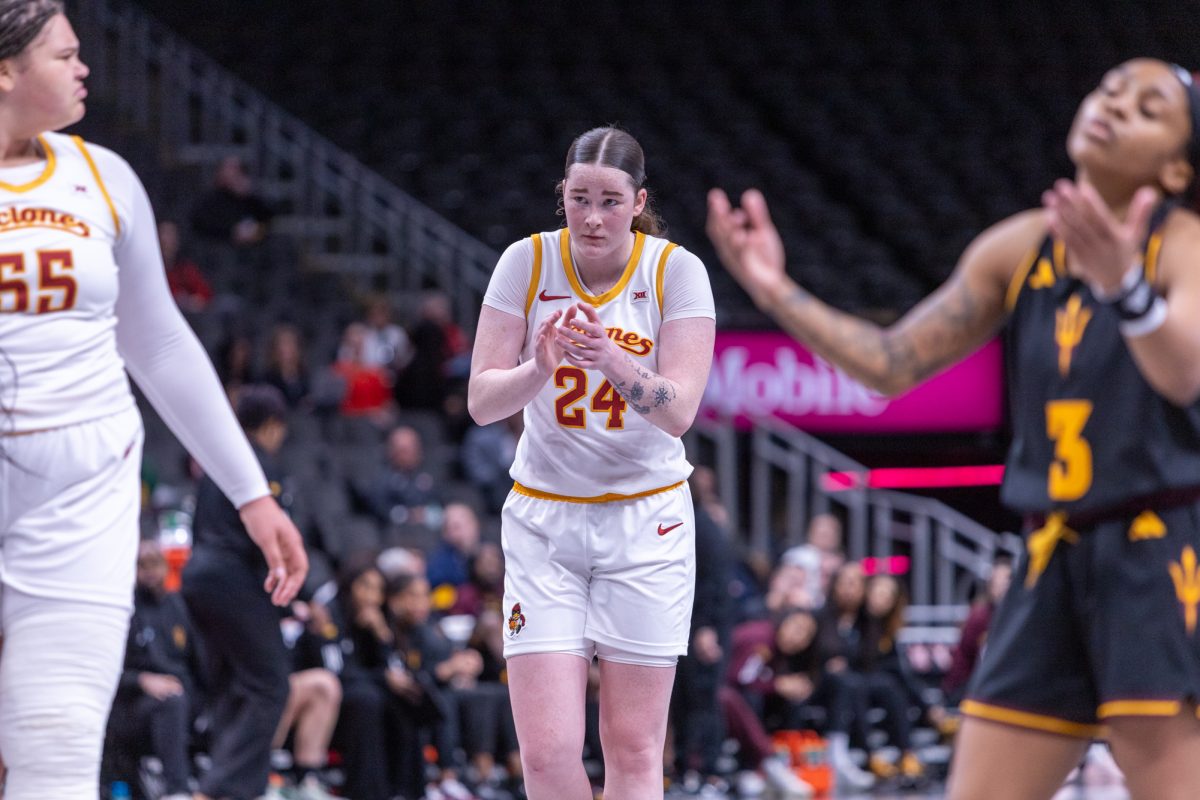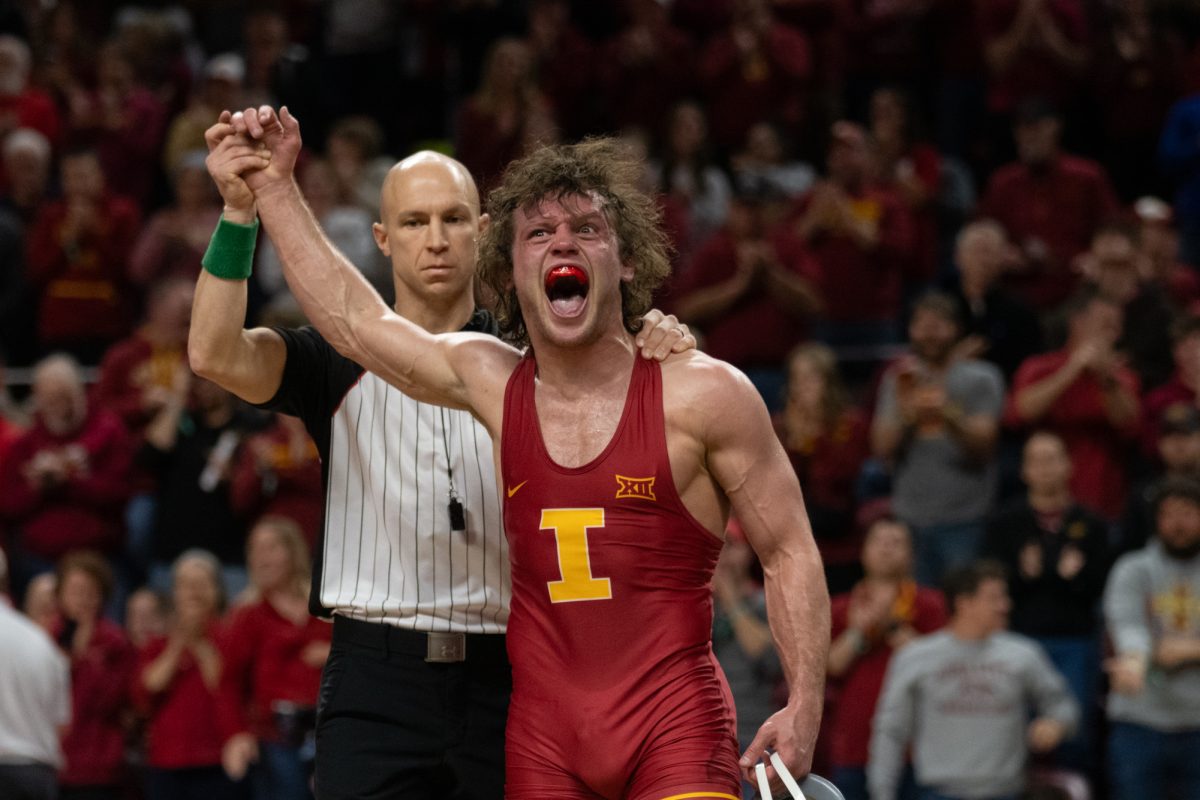President Wintersteen hosts two forums on campus climate survey
May 9, 2018
President Wintersteen held two forums at the Memorial Union on Wednesday afternoon to review the results of the campus climate survey that was open to students, faculty and staff during the fall 2017 semester.
Dan Merson, executive associate and senior research associate at Rankin & Associates Consulting, the consulting firm who developed the survey, presented and interpreted its results.
He began by explaining the intentionally broad definition of campus climate. For the purposes of the study, Merson and his team opened the survey to all Iowa State students, faculty and staff, since the campus environment is “to a great extent, composed by other individuals.”
The official definition of climate for the survey is “current attitudes, behaviors and standards and practices of students and employees of an institution.”
Although the ideal response rate to effectively gather data in climate surveys is 30 percent or above, Merson felt that Iowa State’s 17 percent response rate still provided enough data to make important inferences on different demographics.
More specifically, he talked about the ways race, ethnicity and gender identity can indicate how someone on campus might experience discrimination differently. This can help achieve the goal of the study — to identify and resolve issues with the campus climate — by better addressing those demographics.
Religious affiliation, among other demographics, can also help statisticians like Merson to make important generalizations about certain student groups on campus, with the end goal of preventing people from dropping out.
“Feelings of belonging are the number one indicator of a student having thoughts of leaving college,” Merson said. “What we have found is that religious students typically have a support group and greater senses of belonging, leading to better performance in school.”
Merson said he doesn’t like to benchmark, or compare, schools’ climates to one another, but Iowa State did have a few areas that were interesting. Most notably, Iowa State had a higher than usual number of students, 14, who identified as undocumented or DACA status.
This could suggest that students on campus feel more comfortable than their counterparts at other colleges, only five of which have identified as undocumented across every survey he has conducted since the 2016 election.
When it came to students’ reported feelings, 79 percent said they were comfortable with the overall campus climate, 85 percent said they were comfortable while in the classroom and 73 percent said they were comfortable in their respective department, program or work unit.
While Merson said these numbers were higher than average, the purpose of the study was to identify areas of improvement and to raise the overall climate on campus.
One area that he identified as an area of improvement was regarding instances of harassment among both students and faculty/staff.
When respondents were asked if they had personally experienced exclusionary, intimidating or offensive/hostile conduct, in other words harassment, 19 percent of respondents, a total of 1,375 people, said yes.
Of those 1,375 respondents, 32 percent said they had five or more instances of harassment within the last year. For faculty, most harassment stemmed from gender issues, while staff had issues with feelings of hierarchy and their position as staff.
11 percent of all respondents said that they had experienced “unwanted sexual conduct.”
-
1 percent of respondents said they experienced relationship violence.
-
2 percent of respondents said they experienced stalking.
-
8 percent of respondents said they experienced verbal sexual harassment, like catcalling, and repeated sexual advances.
-
3 percent of respondents said they experienced “unwanted sexual contact”, which indicates sexual assault.
Of these reports, unwanted sexual conduct was more prevalent among students, primarily within their first year, than it was for faculty or staff.
Merson stated that the response to sexual assault on campus may need improving.
After the incidents, 62 percent reported they felt angry, 61 percent said they were embarrassed, 56 percent felt afraid and 57 percent felt somehow responsible. At this point, Merson stated that sexual assault is never, in any case, the victim’s fault.
He then transitioned to examining the events following these incidents, saying that the campus climate, regarding the reporting of misconduct, needs improvement. While 64 percent of respondents told a friend, only 18 percent filed an official report about the incident.
“Reporting assault is important but getting support is more important,” Merson said. “Those who seek support do far better than those who don’t.” With RA’s being mandatory reporters, victims oftentimes don’t have anyone to go, especially when they are just starting college, Merson said.
The reasons most often cited for not reporting the conduct was that they feared the consequences for themselves or the perpetrator, they blamed themselves, it would be too much effort, they had limited details to share or they feared there would not be an adequate response.
Merson suggested that the last reason was partially due to a failure on Iowa State’s end.
“When 18 percent of victims report being assaulted and 55 percent feel that it wasn’t responded to correctly, do you think they will report it again?” Merson asked. “Likely not,” he added.
After the overview of the study, President Wendy Wintersteen talked about Iowa State’s plan to create four teams that would meet in the summer and have additional forums in the fall over the findings and the universities goals to improve the campus climate. The four teams will address undergraduate students, graduate and veterinary students, faculty and professional, scientific and merit staff individually.
2004 was the last time a study like this was conducted on campus and Wintersteen said, like the last survey, “This report is going to be a tremendous asset for us.”
However, during the question and answer period of the first forum, Wesley Harris Jr., a doctoral student in education, expressed that he did not have faith in President Wintersteen and Iowa State to take action on the survey’s results. Harris said he has been a part of the Iowa State community since 2015, the year after the first climate survey, and has not seen the administration do anything “responsive to racially and ethnically minoritized students.”
Harris said, “I want to be proud to be an Iowa State student. I want to say that when I receive my Ph.D., I can tell others to come here, but that hasn’t been my experience. I haven’t been able to honestly and truthfully encourage folks to come here.”
Wintersteen responded by saying, “We are going to have some great opportunities for students to participate in discussions in the fall semester, and I think that will be a nice set of conversations.”
Exiting the room, Harris said, “We need action, not more conversation.”
President Wintersteen agreed, but added, “We have to begin by hearing each other.”
Merson then urged people to read the qualitative comments section in the full report, which lists common themes from student comments on the survey.
When asked about the interaction with Harris in an interview following the forum, President Wintersteen reiterated her sentiment that there will be opportunities for everyone “to see the outcome of the survey and then, in the fall, come participate and talk about the results.”
Speaking on her thoughts moving forward, Wintersteen said, “[Iowa State] learned so much from the 2004 survey and took some very substantive actions. We’re going to have the same thing happen with this survey. We’re going to learn, we’re going to see what our challenges are and we’re going to have conversations widely with campus about the results of this survey.”
For more information on the study, the recording of both the first and second forum and to read the complete report or the executive summary, visit the Iowa State Campus Climate website.
Editors Note: This article has been updated to correct the number of years Harris has been at Iowa State University. A previous version of the article stated he had been at ISU since 2005. A quote from Harris was also corrected from “racial and ethnic minority students” to “racially and ethnically minoritized students.”


